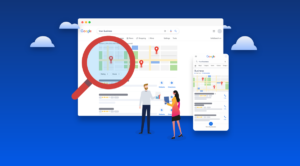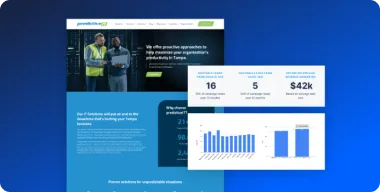If you’re here, chances are you’re looking for real ways to bring more leads into your business heading into 2025.
You know your business better than anyone. Whether you’re in the thick of running day-to-day operations or strategizing for the next quarter, the goal is clear: you need more leads, and you need them to be quality. In this guide, we’re going to break down the essentials of lead generation into clear, manageable steps. We’ll look at proven methods, from Google Ads to SEO, and how to adapt them to your specific business needs and budget.
So, let’s get started on building a lead generation strategy that brings real value to your business.
Quick summary to getting qualified leads
✅ Tailor Your Lead Generation Strategies: Craft lead generation strategies that are specifically tailored to your business’s unique needs, covering everything from PPC advertising and CRO to effective website messaging and SEO.
✅ Balance Immediate and Long-Term Approaches: Balance quick-win tactics for immediate lead generation results with long-term strategies for sustainable growth, including content marketing and relationship building.
✅ Be Adaptable and Continuous Improve: Understand the importance of continuously analyzing and adapting your lead generation strategies to stay aligned with evolving market trends, customer behaviors, and digital advancements.
What is a Lead Generation Strategy?
At its core, a lead generation strategy is a plan designed to attract and convert potential customers into leads for your business. But let’s dig into that a bit. In simple terms, it’s about finding people who are interested in what you offer and then giving them a reason to provide their contact information or engage with your business.

Think of it like fishing.
Your bait is the content or offers you put out there – it could be an informative blog post, a discount code, or a free consultation.
The fish are your potential leads. Some baits work better for certain types of fish, just like some strategies are more effective for different types of customers or businesses.
A successful lead generation strategy considers who your ideal customers are (your target market), where to find them (the right channels), and what will make them bite (the right messaging and offers).
In this section, we’ll explore various components of a lead generation strategy and how you can adapt these tools to fit your business’s unique needs. Whether you’re a B2B company looking to generate more leads or a small business aiming to attract local customers, understanding these fundamentals is the first step in creating a strategy that works for you.
Key Components of a Modern Lead Generation System
PPC Advertising: The Quick Response Unit of Lead Generation
Pay-Per-Click (PPC) advertising is like having a fast-acting team in your lead generation arsenal. It’s direct, it’s targeted, and when done right, it can bring immediate results. Let’s break down what this means for your business.
The Essence of PPC
At its simplest, PPC is a model of online advertising where you pay a fee each time someone clicks on your ad. It’s a way of buying visits to your site, rather than attempting to “earn” those visits organically. Think of it as a shortcut to getting in front of potential customers who are actively searching for what you offer.
Choosing the Right Platform
The most common platforms for PPC are search engines like Google (Google Ads) and social media sites like Facebook and LinkedIn. Each platform serves a different purpose:
Google Ads: Ideal for capturing high-intent traffic. People searching on Google are often ready to make a decision or purchase.
Social Media Ads (Facebook, LinkedIn, Instagram): These are great for building brand awareness and targeting based on specific demographics, interests, and behaviors.
Crafting Your Campaign
A successful PPC campaign starts with understanding your audience. What are they searching for? What kind of language resonates with them? Your ads should be tailored to answer these questions, with clear, compelling copy and a strong call-to-action.
Measuring Success
The beauty of PPC is in its measurability. You can track how many people saw your ad, clicked on it, and ultimately, how many took the desired action on your website. This data is crucial for refining your campaigns and ensuring you get the best return on your investment.
Budgeting Wisely
PPC can be cost-effective, but it requires smart budgeting. Start small, test what works, and gradually increase your spend on the campaigns that show the most promise.
Conversion Rate Optimization: Turning Visitors into Leads
Conversion Rate Optimization (CRO) is about making the most of the traffic you already have. It’s the art and science of converting visitors into leads or customers. Here’s how CRO can play a pivotal role in your lead generation strategy.Understanding CRO
CRO involves tweaking and testing various elements of your website to increase the percentage of visitors who take a desired action. This could be filling out a contact form, signing up for a newsletter, or making a purchase. It’s not just about driving traffic; it’s about driving the right kind of traffic and making sure that traffic takes action.The Role of User Experience
A key aspect of CRO is user experience (UX). If your website or landing page is difficult to navigate, slow to load, or not mobile-friendly, chances are you’re losing potential leads. Simple changes like improving page load times, making navigation intuitive, and having clear, compelling calls to action can significantly boost your conversion rates.Data-Driven Decisions
CRO is grounded in data. Use tools like Google Analytics to understand where your visitors are dropping off and A/B testing to try out different website elements. This could be anything from the color of a ‘submit’ button to the wording of your headlines. The goal is to make informed decisions based on what actually works for your audience.Continuous Improvement
CRO isn’t a one-time fix; it’s an ongoing process. Consumer behaviors change, new trends emerge, and your website needs to evolve to keep up. Regularly reviewing and updating your website based on performance data ensures that your lead generation efforts remain effective.Aligning with Your Business Goals
Every tweak and test should align with your overall business objectives. Whether it’s increasing newsletter sign-ups, boosting product sales, or generating more inquiries, your CRO efforts should be focused on what matters most to your business.Lead Collection and Nurturing: Building Lasting Relationships with Prospects
Lead collection and nurturing are about more than just gathering contact information; it’s about building and maintaining relationships with potential customers. This process is crucial in converting leads into loyal customers. Let’s dive into how you can effectively collect and nurture leads.Effective Lead Collection
The first step is to collect leads through various channels like your website, PPC ads, social media, or even in-person events. The key is to offer something valuable in exchange for their contact information. This could be an informative eBook, a free consultation, or an audit. Ensure that the process is straightforward and respects the user’s privacy.Segmenting Your Leads
Not all leads are the same. Segment your leads based on their interests, behaviors, or how they found your business. This allows you to tailor your communication and offers to suit their specific needs, increasing the chances of conversion.The Art of Nurturing
Lead nurturing involves regularly engaging with your leads through targeted content, emails, newsletters, social media interactions, or even personalized offers. The goal is to provide value, establish trust, and keep your brand top-of-mind. Remember, nurturing is a gentle process; it’s about guiding, not pushing.Utilizing Automation Tools
Leverage automation tools to streamline your lead nurturing process. Tools like Active Campaign, Pipedrive, and GoHighLevel can help you manage leads, track their interactions with your business, and automate personalized communication. This ensures consistent engagement without overwhelming your team.Measuring and Refining
Track the effectiveness of your lead nurturing efforts. Look at metrics like email open rates, click-through rates, and conversion rates. Use this data to refine your approach, test different strategies, and continuously improve the relationship-building process.Effective Website Messaging: Communicating Your Value Clearly
Effective website messaging is crucial in capturing and retaining the interest of potential leads. It’s about conveying your value proposition in a way that resonates with your audience and prompts action. Let’s explore how to craft messaging that connects and converts.Clarity is Key
Your website visitors should immediately understand what you offer and why it matters to them. Avoid industry jargon and complex language. Instead, use clear, concise wording that speaks directly to your audience’s needs and pain points.Tailoring Your Message
Understand who your audience is and tailor your message to speak to them specifically. A message that appeals to a young entrepreneur might not resonate with a seasoned executive. Segment your audience and create messaging that addresses the unique challenges and desires of each group.Strong Calls to Action (CTAs)
Your CTAs are the signposts guiding visitors towards taking action, whether it’s signing up, making a purchase, or getting in touch. Make sure your CTAs are prominent, persuasive, and clearly state what the visitor will gain by clicking.Consistency Across Channels
Ensure that your messaging is consistent across all platforms – your website, social media, email campaigns, and other marketing materials. Consistency helps build brand recognition and trust.Test and Optimize
What works today might not work tomorrow. Regularly test different aspects of your website messaging – from headlines to button texts – and see what resonates best with your audience.Storytelling
People connect with stories. Use storytelling to make your brand more relatable and memorable. Share customer success stories, the journey of your brand, or how your product/service solves problems in a relatable way.SEO: Fueling Long-Term Organic Growth
Search Engine Optimization (SEO) is a fundamental component of any lead generation strategy, focusing on growing your online visibility in organic search engine results. It’s a long-term investment that can significantly boost your credibility and lead inflow. Here’s how to leverage SEO effectively.Understanding SEO
SEO involves optimizing your website and content to rank higher in search engine results for relevant keywords. It’s about being where your potential customers are looking and ensuring they find you.
Keyword Research
Start with identifying the keywords your target audience uses when searching for products or services like yours. Tools like Ahrefs and Google Trends can help. Remember, it’s not just about high traffic keywords but also about relevance and intent.
On-Page Optimization
Ensure that each page on your website is optimized for search engines. This includes using the right keywords in your titles, headings, and content, optimizing your images, and ensuring your website is mobile-friendly and loads quickly.
Quality Content is King
Regularly produce high-quality, informative content that addresses your audience’s questions and needs. This not only helps with SEO but also establishes your brand as an authority in your field.
Building Backlinks
Backlinks from reputable websites signal to search engines that your site is a credible source of information. Focus on building relationships with industry leaders, guest blogging, and creating shareable content.
Local SEO for Local Businesses
If you’re a local business, local SEO is crucial. This includes optimizing your Google My Business listing, getting listed in local directories, and ensuring your NAP (Name, Address, Phone Number) consistency across the web.
Monitoring and Adapting
SEO is not a set-it-and-forget-it strategy. Regularly monitor your rankings, traffic, and other key metrics. Stay updated with the latest SEO trends and algorithm updates, and be ready to adapt your strategy accordingly.
Having explored the key components of a modern lead generation system, it’s clear that each element plays a vital role in attracting and converting leads. However, the effectiveness of these components isn’t just in their individual strengths but in how well they are adapted to the specific needs and context of your business.
This brings us to an essential aspect of lead generation: tailoring your strategy to align with your business’s unique goals and resources.
Adapting Your Strategy to Your Business Needs
Customizing Your Lead Generation Approach for Maximum Impact
A successful lead generation strategy isn’t a one-size-fits-all solution; it needs to be customized to fit the unique aspects of your business. Here’s how you can adapt the key components we’ve discussed to meet your specific business needs.
Assess Your Business Type and Audience
Start by understanding the nature of your business and your target audience. Are you a B2B company with a niche market, or a B2C business targeting a broader audience? The answer will influence which lead generation tactics will be most effective for you. Here’s how:
For B2B Companies with a Niche Market
Tactics: Focus on building strong, personalized relationships. Your lead generation should lean towards high-quality, targeted content, like whitepapers, industry reports, and webinars that address specific industry pain points.
Why It Works: B2B purchasing decisions are often complex and involve multiple stakeholders. Providing detailed, expert content helps establish trust and authority, key factors in B2B sales cycles.
For B2C Businesses Targeting a Broader Audience
Tactics: Utilize broader-reaching strategies like social media campaigns, influencer partnerships, and SEO optimized for general keywords. Engaging and relatable content that resonates on a personal level can be more effective.
Why It Works: B2C purchasing decisions are usually more impulsive and emotionally driven. Broad-reaching strategies help increase brand visibility and appeal to a wider audience, tapping into their immediate needs and desires.
Common Ground
Data-Driven Approach: Regardless of B2B or B2C, using data to understand your audience is crucial. Analytics can reveal insights about customer behavior, preferences, and engagement patterns, helping tailor your tactics more effectively.
Adaptability: Markets and consumer behaviors are constantly evolving. Regularly review and adjust your strategies based on performance data and market trends to stay relevant and effective.
By aligning your lead generation tactics with the specific characteristics of your business and target audience, you can create more focused, effective campaigns that resonate with your potential customers and yield better results.
Identify Your Goals
When setting out your lead generation strategy, it’s crucial to first define your goals. What are you looking to achieve with your lead generation efforts? Is it increasing brand awareness, driving more sales, or building a subscriber base? Your goals will dictate the direction and focus of your lead generation strategy. Here’s how different goals can shape your approach:
Increasing Brand Awareness
Tactics: Utilize broad-reaching platforms like social media, content marketing, and PR campaigns. Focus on creating shareable content and engaging with your audience through storytelling and brand messaging.
How It Works: These tactics help put your brand in front of a larger audience. The more people see and interact with your content, the more recognizable your brand becomes. This is especially effective for new businesses or those entering new markets.
Driving More Sales
Tactics: Implement targeted advertising (like PPC), email marketing campaigns with special offers, and optimize your website for conversions. Consider retargeting ads to re-engage visitors who didn’t make a purchase.
How It Works: These tactics are designed to directly influence purchasing decisions. By targeting individuals who have shown interest in your products or services, you can guide them through the sales funnel more effectively.
Building a Subscriber Base
Tactics: Offer valuable resources in exchange for email sign-ups, such as eBooks, webinars, or exclusive content. Use engaging CTAs on your website and social media channels to encourage subscriptions.
How It Works: By providing value upfront, you can attract individuals who are interested in your content. This helps you build a list of engaged subscribers whom you can nurture over time, leading to more sustained engagement and potential sales.
Common Strategies
Personalization: Tailor your messages and offers based on user behavior and preferences. Personalization can increase the effectiveness of your tactics, regardless of your goal.
Measurement and Adjustment: Regularly track the performance of your strategies against your goals. Use data-driven insights to refine and adjust your approach for better results.
By aligning your lead generation tactics with your specific business goals, you can create a focused strategy that not only reaches the right audience but also drives the desired outcomes, whether that’s brand recognition, sales, or a loyal subscriber base.
Evaluate Your Resources
Consider the resources you have at your disposal – this includes budget, time, and manpower. A smaller business might focus more on cost-effective SEO and content marketing, while a larger enterprise might invest heavily in PPC campaigns and advanced automation tools.
Choose the Right Mix of Tactics
Selecting the right mix of lead generation tactics is crucial and should be based on your business type, goals, and resources. Here are two example cases illustrating how different combinations of tactics can be effective:
Case 1: SEO and Content Marketing for a Legal Consulting Firm
Business Type: A legal consulting firm offering compliance and regulatory advice.
Goals: Establishing thought leadership in the legal sector and achieving long-term organic growth.
Tactics:
- SEO: Focusing on keywords related to legal compliance and regulatory advice to improve search engine rankings.
- Content Marketing: Publishing detailed blog posts, whitepapers, and hosting webinars on legal updates, compliance strategies, and case studies demonstrating their expertise.
Outcome: Gradual increase in organic traffic with higher engagement rates. Their authoritative content is frequently cited in legal forums and publications, enhancing their reputation and leading to more client inquiries and engagements.
Case 2: PPC Advertising and Email Marketing for a Financial Advisory Service
Business Type: A financial advisory service specializing in wealth management for high-net-worth individuals.
Goals: Generating immediate client inquiries and building a base of long-term clients.
Tactics:
- PPC Advertising: Targeted ad campaigns on financial news sites and forums to attract potential clients seeking wealth management services.
- Email Marketing: Developing a newsletter providing insights on market trends, investment tips, and firm updates to nurture leads and keep the firm top-of-mind.
Outcome: Quick increase in inquiries from PPC, with a growing list of engaged subscribers through email marketing, leading to a steady stream of new clients and repeat business.
Case 3: Comprehensive Strategy for a Managed Service Provider (MSP)
Business Type: A Managed Service Provider offering IT solutions and support to small and medium-sized businesses.
Goals: Enhancing brand visibility, generating high-quality leads, and establishing long-term client relationships.
Tactics:
- SEO: Implementing an SEO strategy targeting keywords related to IT solutions, managed services, and industry-specific IT challenges.
- Content Marketing: Creating informative blog posts, how-to guides, and hosting webinars on IT management, cybersecurity, and cloud solutions.
- PPC Advertising: Running targeted ads on technology platforms and business forums to reach businesses in need of managed IT services.
- Email Marketing: Developing a newsletter series offering IT tips, company updates, and case studies of successful IT projects.
- Social Media Engagement: Actively engaging on platforms like LinkedIn, sharing industry news, IT tips, and insights to build a community and foster relationships.
Outcome: The MSP experiences a multi-layered impact: increased online authority and organic traffic from SEO and content marketing, immediate lead generation from PPC, and ongoing client engagement and retention through email marketing and social media efforts.
Monitor, Analyze, and Refine
Continuously monitor the performance of your tactics, analyze the results, and make necessary adjustments. This iterative process ensures that your strategy remains effective and relevant over time.
By thoughtfully adapting these strategies to your business, you can create a lead generation plan that not only attracts more leads but also nurtures them into loyal customers.
Capitalizing on Immediate Opportunities for Lead Generation
Quick wins in lead generation are about identifying and leveraging opportunities that can bring immediate results. Here’s how you can spot and capitalize on these opportunities:Identify Low-Hanging Fruit
Start by looking for the easiest opportunities to generate leads. This could be optimizing a high-traffic webpage for conversions, launching a time-sensitive promotional campaign, or leveraging trending topics in your content marketing.Utilize Existing Networks and Relationships
Your existing networks, such as current customers, social media followers, or email subscribers, can be a great source of quick leads. Engage with them through special offers, referral programs, or exclusive content.Optimize for High-Intent Keywords
In your SEO and PPC efforts, focus on high-intent keywords – terms that indicate a strong purchase intent. These keywords often have lower competition and can drive quick conversions.Implement Targeted Social Media Ads
Social media platforms offer powerful targeting options. Use them to reach a specific audience quickly with ads tailored to their interests and behaviors.Leverage Time-Sensitive Offers
Create urgency with limited-time offers or flash sales. This can prompt quick decisions from potential leads who might be on the fence.Case Studies and Success Stories
Showcasing quick wins from your existing customers can be a powerful tool to attract new leads. Share case studies or success stories that highlight the immediate benefits of your product or service.Measure and Learn
Track the performance of these quick win strategies. Analyze what works and apply these learnings to refine your ongoing lead generation efforts. Quick wins are an excellent way to see immediate growth in your lead generation efforts and can set the stage for more sustained, long-term strategies.While quick wins are important for immediate results, the true strength of a lead generation strategy lies in its capacity for long-term growth. Investing in strategies that build and sustain growth over time is crucial for the enduring success of your business.
Investing in Long-Term Growth
Building a Sustainable Foundation for Continuous Lead Generation
Long-term growth in lead generation requires a strategic approach focused on sustainability and continuous improvement. Here’s how you can invest in strategies that pay off in the long run:
Develop a Content Marketing Strategy
Content is a powerful tool for long-term lead generation. Develop a content marketing strategy that provides valuable, relevant content to your audience consistently. This could include blog posts, whitepapers, webinars, or videos. Quality content helps establish your brand as an authority and keeps you top-of-mind with potential leads.
Strengthen Your SEO Efforts
SEO is a marathon, not a sprint. Invest in a robust SEO strategy that includes optimizing your website, building quality backlinks, and regularly updating your content to keep up with search engine algorithms. This will help you maintain a steady flow of organic traffic over time.
Foster Customer Relationships
Building strong relationships with your existing customers can lead to repeat business, profitable testimonials, and referrals. Implement customer relationship management (CRM) practices, maintain regular communication, and provide exceptional service to turn customers into brand advocates.
Embrace Marketing Automation
Marketing automation tools can help streamline your lead generation and nurturing processes. Automate repetitive tasks like email marketing, social media posting, and lead scoring to increase efficiency and personalize the customer experience.
Continuously Analyze and Adapt
You’ve probably noticed a common theme at this point, and there’s a reason we’re nailing down on it so much. It’s because the digital landscape online is always changing. So, again, regularly analyze your lead generation strategies to understand what’s working and what isn’t. Stay adaptable and be willing to pivot your strategies in response to market changes, customer feedback, and new technologies.
Invest in Training and Development
Your team is your greatest asset in long-term growth. Invest in their training and development to keep them up-to-date with the latest marketing trends and techniques.
By focusing on these long-term strategies, you can build a sustainable lead generation system that not only attracts leads but also nurtures them into loyal customers, ensuring the ongoing success of your business.
Bringing It All Together: Your Path to Lead Generation Success
In this guide, we’ve navigated through the various facets of creating a lead generation strategy that’s not just effective but also adaptable to your unique business needs. Let’s recap the key points:
Understand Your Unique Needs: Every business is different. Tailor your lead generation strategy to fit your specific audience, goals, and resources.
Balance Quick Wins with Long-Term Growth: While quick wins provide immediate results, long-term strategies ensure sustainable growth. Strive for a balance between the two.
Leverage the Right Mix of Tactics: From PPC advertising and CRO to content marketing and SEO, use the right combination of tactics that align with your business objectives.
Build Relationships: Lead generation is not just about numbers; it’s about building lasting relationships with your customers.
Stay Adaptable and Informed: The digital landscape is ever-evolving. Stay informed and be ready to adapt your strategies as needed.
Remember, lead generation is a journey, not a destination. It requires patience, persistence, and a willingness to learn and adapt. Whether you’re just starting out or looking to refine your existing strategies, the steps outlined in this guide are designed to help you navigate the path to lead generation success.
If you’re ready to take your lead generation to the next level but need some guidance, Pronto Marketing is here to help. Contact us for a customized strategy that aligns with your business needs and sets you on the course for growth and success.






